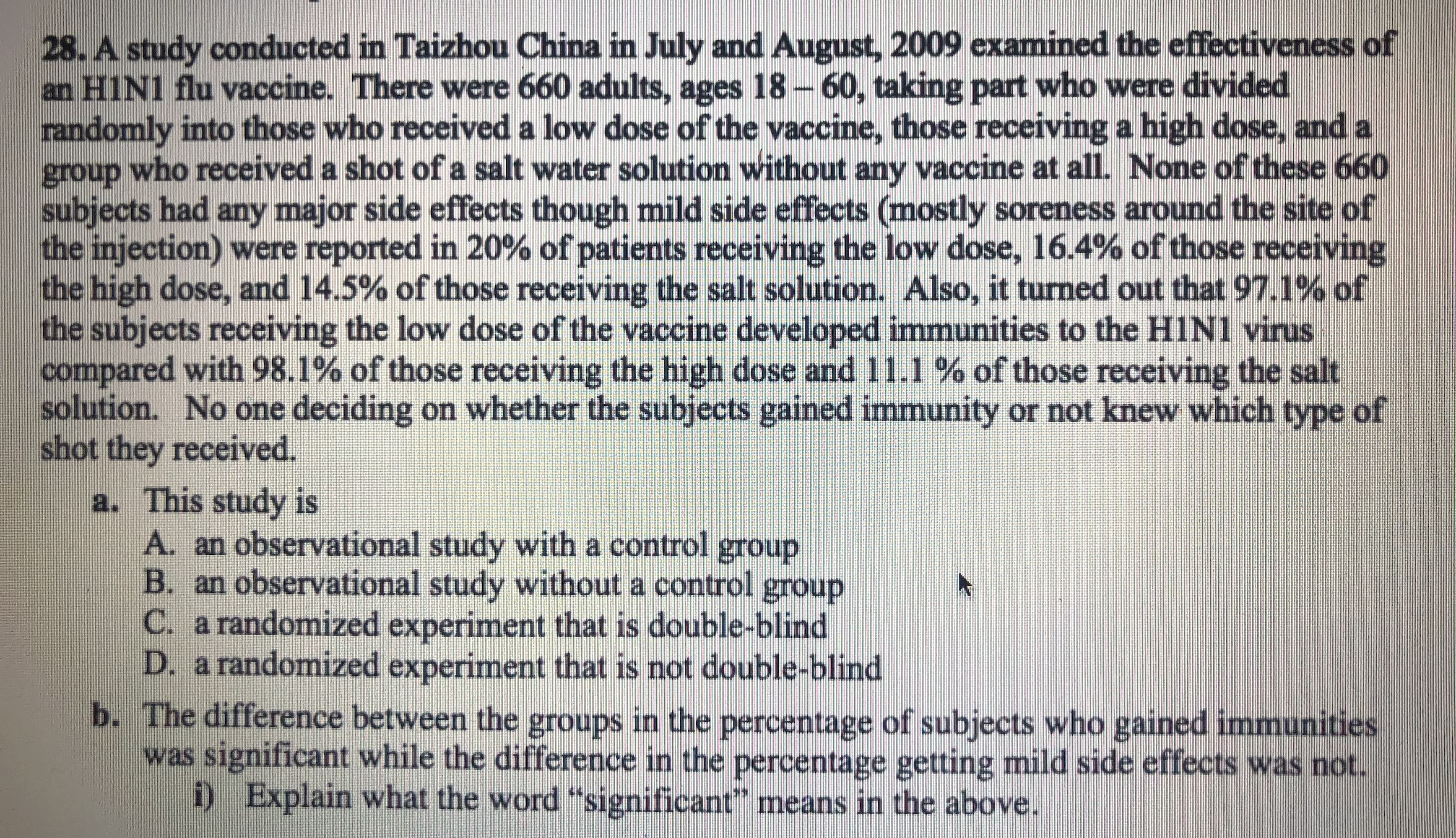28. A study conducted in Taizhou China in July and August, 2009 examined the effectiveness of an HIN1 flu vaccine. There were 660 adults, ages 18-60, taking part who were divided randomly into those who received a low dose of the vaccine, those receiving a high dose, and a group who received a shot of a salt water solution without any vaccine at all. None of these 660 subjects had any major side effects though mild side effects (mostly soreness around the site of the injection) were reported in 20% of patients receiving the low dose, 16.4% of those receiving the high dose, and 14.5% of those receiving the salt solution. Also, it turned out that 97.1% of the subjects receiving the low dose of the vaccine developed immunities to the HIN1 virus compared with 98.1% of those receiving the high dose and 11.1 % of those receiving the salt solution. No one deciding on whether the subjects gained immunity or not knew which type of shot they received. a. This study is A. an observational study with a control group B. an observational study without a control group C. a randomized experiment that is double-blind D. a randomized experiment that is not double-blind b. The difference between the groups in the percentage of subjects who gained immunities was significant while the difference in the percentage getting mild side effects was not. i) Explain what the word "significant" means in the above.
28. A study conducted in Taizhou China in July and August, 2009 examined the effectiveness of an HIN1 flu vaccine. There were 660 adults, ages 18-60, taking part who were divided randomly into those who received a low dose of the vaccine, those receiving a high dose, and a group who received a shot of a salt water solution without any vaccine at all. None of these 660 subjects had any major side effects though mild side effects (mostly soreness around the site of the injection) were reported in 20% of patients receiving the low dose, 16.4% of those receiving the high dose, and 14.5% of those receiving the salt solution. Also, it turned out that 97.1% of the subjects receiving the low dose of the vaccine developed immunities to the HIN1 virus compared with 98.1% of those receiving the high dose and 11.1 % of those receiving the salt solution. No one deciding on whether the subjects gained immunity or not knew which type of shot they received. a. This study is A. an observational study with a control group B. an observational study without a control group C. a randomized experiment that is double-blind D. a randomized experiment that is not double-blind b. The difference between the groups in the percentage of subjects who gained immunities was significant while the difference in the percentage getting mild side effects was not. i) Explain what the word "significant" means in the above.
Glencoe Algebra 1, Student Edition, 9780079039897, 0079039898, 2018
18th Edition
ISBN:9780079039897
Author:Carter
Publisher:Carter
Chapter10: Statistics
Section10.6: Summarizing Categorical Data
Problem 28PPS
Related questions
Question

Transcribed Image Text:28. A study conducted in Taizhou China in July and August, 2009 examined the effectiveness of
an HIN1 flu vaccine. There were 660 adults, ages 18-60, taking part who were divided
randomly into those who received a low dose of the vaccine, those receiving a high dose, and a
group who received a shot of a salt water solution without any vaccine at all. None of these 660
subjects had any major side effects though mild side effects (mostly soreness around the site of
the injection) were reported in 20% of patients receiving the low dose, 16.4% of those receiving
the high dose, and 14.5% of those receiving the salt solution. Also, it turned out that 97.1% of
the subjects receiving the low dose of the vaccine developed immunities to the HIN1 virus
compared with 98.1% of those receiving the high dose and 11.1 % of those receiving the salt
solution. No one deciding on whether the subjects gained immunity or not knew which type of
shot they received.
a. This study is
A. an observational study with a control group
B. an observational study without a control group
C. a randomized experiment that is double-blind
D. a randomized experiment that is not double-blind
b. The difference between the groups in the percentage of subjects who gained immunities
was significant while the difference in the percentage getting mild side effects was not.
i)
Explain what the word "significant" means in the above.
Expert Solution
This question has been solved!
Explore an expertly crafted, step-by-step solution for a thorough understanding of key concepts.
Step by step
Solved in 3 steps

Recommended textbooks for you

Glencoe Algebra 1, Student Edition, 9780079039897…
Algebra
ISBN:
9780079039897
Author:
Carter
Publisher:
McGraw Hill

Glencoe Algebra 1, Student Edition, 9780079039897…
Algebra
ISBN:
9780079039897
Author:
Carter
Publisher:
McGraw Hill